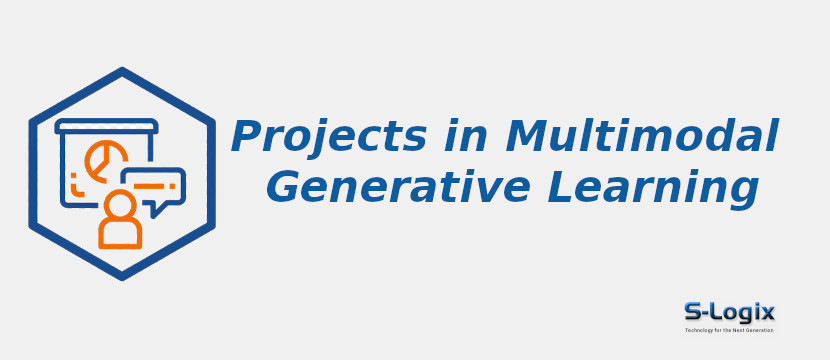Project Background:
Multimodal generative learning stems from the intersection of two powerful paradigms in artificial intelligence: generative modeling and multimodal data processing. Generative learning focuses on training models to understand and replicate the underlying distribution of a dataset, enabling the creation of novel, realistic samples. Challenges intensify in the context of multimodal data, where information comes from diverse sources such as images, text, and audio, demanding sophisticated models capable of capturing the intricate dependencies and correlations between modalities. This project is motivated by the need to develop advanced generative models beyond unimodal frameworks, effectively synthesizing and generating content that aligns with the complexity of real-world, multimodal data. It leverages techniques such as variational autoencoders, generative adversarial networks, and attention mechanisms to integrate information from different modalities seamlessly. Additionally, the project seeks to address the interpretability of generative models, ensuring that the synthesized outputs are realistic, interpretable, and coherent across modalities.
Problem Statement
- Multimodal generative learning revolves around the complexities of training models to generate coherent and realistic content across multiple modalities.
-
While significant strides have been made in generative learning within unimodal domains, extending these capabilities to multimodal scenarios introduces unique challenges.
-
The project seeks to address issues such as the intricate dependencies and correlations between different modalities, ensuring that generative models can effectively capture and synthesize diverse forms of information, including text, images, and audio.
-
Challenges include the development of architectures that can seamlessly integrate and represent information from various modalities and achieving a balanced generation of content that maintains consistency across multiple sources.
-
Moreover, the interpretability of generated multimodal content poses a critical challenge, necessitating exploring techniques that allow users to understand and control the generative process.
Aim and Objectives
- The multimodal generative learning project aims to advance the capabilities of generative models to synthesize coherent and realistic content across multiple modalities, including text, images, and audio.
-
Develop architectures that seamlessly integrate information from diverse modalities for effective generative learning.
-
Address challenges related to potential biases in generative models, ensuring balanced generation across different sources.
-
Achieve consistency in generated content across multiple modalities, maintaining coherence and quality.
-
Explore techniques to enhance the interpretability of multimodal generative models, allowing users to understand and control the generative process.
-
Enable generative models to produce diverse and meaningful content, fostering innovation and creativity in various application domains.
-
Enhance the realism of synthesized content, ensuring that generated samples closely resemble the characteristics of real-world multimodal data.
-
Develop robust models for shifts in data distributions across modalities, ensuring reliable performance in dynamic environments.
-
Apply multimodal generative learning techniques to specific applications, such as computer vision, natural language processing, and creative arts, demonstrating practical utility.
Contributions to Multimodal Generative Learning
1. Developing novel generative architectures for multimodal learning enables seamless integration and synthesis of diverse content from text, images, and audio.
2.
Addressing and mitigating modality-specific biases in generative models ensure a balanced and fair generation across different sources.
3.
Achieving a high level of consistency in the generated content across multiple modalities enhancing coherence and quality in multimodal synthesis.
4.
Exploring and implementing techniques to enhance the interpretability of multimodal generative models, allowing users better understanding and control over the generative process.
5.
Enabling generative models to produce diverse and meaningful content fosters creativity and innovation in various application domains.
6.
Applied multimodal generative learning techniques to specific applications, showcasing practical utility and demonstrating the adaptability of the developed models.
Deep Learning Algorithms for Multimodal Generative Learning
- Variational Autoencoders (VAEs) for Multimodal Learning
-
Generative Adversarial Networks (GANs) with Multimodal Architectures
-
Attention-based Generative Models for Multimodal Data
-
Cross-Modal Retrieval Networks with Generative Components
-
Multimodal Transformer Models for Generative Learning
-
Graph Neural Networks for Multimodal Generative Tasks
-
Hierarchical Generative Models
-
Adversarially Regularized Multimodal Autoencoders
-
Conditional Multimodal Generative Models
-
Joint Variational Generation and Classification Models
Datasets for Multimodal Generative Learning
- MM-Faust
-
MIMIC-CXR-JPG
-
COCO
-
MS COCO + Captions
-
Audiomnist
-
CMU-MOSEI
-
FashionGen
-
IEMOCAP
-
VATEX
Performance Metrics for Multimodal Generative Learning
- Multimodal FID
-
Cross-Modal Retrieval Accuracy
-
Intra-Modal Diversity
-
Perceptual Similarity
-
Multimodal KL Divergence
-
Content Preservation
-
Modality-Specific Fidelity
-
Generative Task-Specific Metrics (e.g., BLEU score for text generation)
-
Mean Squared Error (MSE) for Image Reconstruction
-
Cross-Modal Consistency Score
Software Tools and Technologies:
Operating System: Ubuntu 18.04 LTS 64bit / Windows 10
Development Tools: Anaconda3, Spyder 5.0, Jupyter Notebook
Language Version: Python 3.9
Python Libraries:
1. Python ML Libraries:
- Scikit-Learn
- Numpy
- Pandas
- Matplotlib
- Seaborn
- Docker
- MLflow
2. Deep Learning Frameworks:
- Keras
- TensorFlow
- PyTorch
